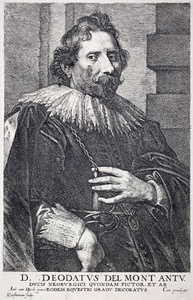| Method | Etching and engraving |
| Artist | Lucas Vorsterman after Anthony van Dyck |
| Published | [c. 1630-1645. 18th century impression.] |
| Dimensions | Image 210 x 145 mm, Plate 236 x 155 mm, Sheet 240 x 157 mm |
| Notes |
A half length portrait of the artist Deodat Delmont, wearing a doublet with large flat lace collar under a luxurious overcoat, and holding a thin sword. From "Icones Principum Virorum", published in various editions between 1630-1645. Deodat Delmont or Deodatus van der Mont (1582-1644) was a Flemish painter and draftsman whose family moved to Antwerp when he was a child. He studied with Pieter Paul Rubens ans travelled with him to Italy. he became a master of the Antwerp St Luke Guild in 1608. From 1614 on he worked as a court artist for both the Spanish King and in Germany for Wolfgang Wilhelm von der Pfalz. He returned to Antwerp in 1620, and stayed there for the rest of his life Inscription to lower margin: "D. Deodatvs del Mont Antv. Dvcis Neobvrgici Qvondam Pictor, et ab eodam eqvestri gradv decoratvs. Ant. Dyck pinxit LVosterman sculp. Cum privilegio" Lucas Vorsterman (1595-1675) was a Flemish engraver, active in Antwerp. He worked in Pieter Paul Rubens' studio from c. 1617 and soon became the painter's primary engraver. Rubens was a very demanding employer and got in a fight with Vorsterman, after having fired many of the other engravers resulting in more pressure landing on Vorsterman's shoulders. In 1624 Vorsterman moved to England, working for patrons such as Thomas Howard, 2nd Earl of Arundel and Charles I of England, before returning to Antwerp 1630. Back in Antwerp he collaborated with Anthony Van Dyck, for example on the publication of artists' portraits in "Iconographie". Anthony van Dyck (1599-1641) was one of the most prominent Flemish Baroque painters. Born in Antwerp, he was a pupil of Hendrik van Balen, but was soon noticed by Rubens with whom he would work closely during his early career. Van Dyck became a master of the St Luke Guild in 1618, went on to paint in Italy from 1621-1626, and then worked predominantly in England from 1632 onwards, where he was knighted by Charles I. Van Dyck was very prolific, he produced many portraits for members of the European aristocracy, as well as religious and mythological paintings and works on paper. New Hollstein Dutch, Van Dyck, 58, vi/viii. Condition: Small tear to bottom margin. |
| Framing | unmounted |
| Price | £80.00 |
| Stock ID | 46165 |

